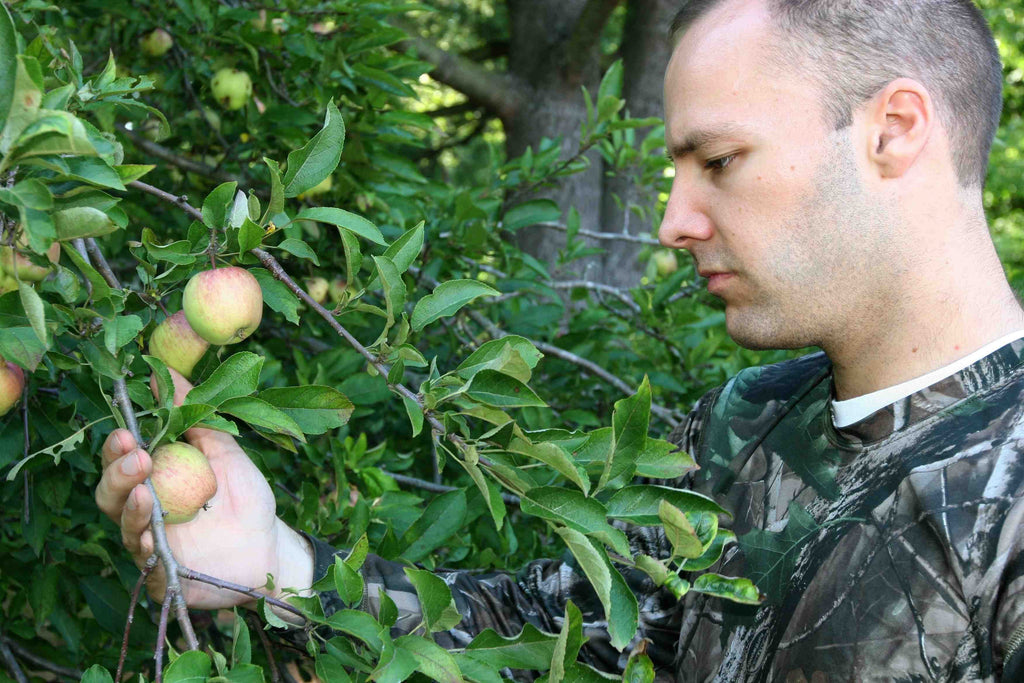hunting-blinds
stands

Big Bucks on Small Parcels
7 min read
As farm land gets turned into strip malls and Wal-Mart parking lots and as the large wooded lot behind our houses gets tuned into another subdivision more and more of us are being forced to hunt deer on smaller tracts of land. 20 years ago it wasn’t uncommon for most of us to have hundreds of acres we could hunt simply by knocking on a farmers door or making a phone call. Times have changed. Now many of us find ourselves hunting on 50 acres or less. If we are lucky we have an 80 or 100 acres lease. Trying to hold deer on a small piece of property and take a large buck can be a huge challenge but the truth is it’s not impossible.
Big Bucks Can Live Anywhere
Noted whitetail biologist CJ Winand spends a lot of time hunting on small tracts of land in suburbia America largely to thin out deer numbers. He says one good thing about deer is they can live anywhere.
“Deer are very good at adapting to the amount of woods they have available” Winand said. “Just because hunters are forced to hunt small woods doesn’t mean they can’t harvest a whopper. I have seen several large bucks taken off of small parcels of land that I manage. To keep deer on small parcels of land deer need food and shelter without a lot of pressure.”
A few years ago I experienced what Winand is talking about first hand. Behind a local church is a small wood lot about 15 acres in size. On occasion I would see deer milling around on the property so I decided to place a scouting camera in the wood lot to see what kind of bucks this small tract of land had to offer the suburbia hunter.
To my surprise within a week I got pictures of several bucks on the camera. A couple of them were nice bucks for my area. One buck in particular scored well over Pope and Young. What does the 15 acres have to offer the big buck. everything he needs.
“Suburbia deer often have it made because they have water, grass and no hunting pressure so they can survive on very small tracts of land for years and years” Winand said.
Change Things Up
If you have 40 acres to hunt out in the middle of farm country or in the middle of town realize you can increase the amount of time deer spend on your property if you are willing to do a little work. “For starters everyone knows that bucks respond to pressure very quickly. On small tracts of land it won't take much human pressure to make a buck change his routine” Winand said.

A recent study showed that permanent stands that have been hung in a tree and left there for years can quickly destroy a great hunting spot. “Studies have shown deer will go 60-100 yards out of their way to avoid treestands when they know they are there” Winand said. How many of us when hunting small woods have one or two stand locations and they are the same every year. Deer will quickly catch on to the game. “I suggest hunters move their stands or blinds every once in a while, all it take sometimes is moving a stand 20 or 30 yards and they are back in the zone.”
Stay Out
Also keep human activity on your property to a minimum. “Deer will quickly catch on to an increased amount of human pressure in their core area so it is best to get in and get out when planting plots, putting in scouting cameras and hanging stands,” Winand explained. “Unless you are hunting an area that sees a lot of human activity all the time staying out of the woods as much as possible is a good idea.” Winand also suggests never hunting a stand location more then twice a week. Any more then that and the deer will probably avoid the area.
Plant Fruit Trees
Making sure the deer always have something to eat on a small property will also keep them on the property more.
“The biggest problem with small wood lots is in many cases deer will travel through them but they don’t live their. To make a deer live on your property you must provide them with food and shelter, which isn’t as hard to do as many people think”.

Winand suggests that hunters plant fruit growing trees. Deer love apples but many people don’t think about planting a few on their property because many people believe they take forever to grow. Many crab apple varieties and normal table apples can be grown relatively quickly with a little bit of care. Placing cages over them and a weed mat of some kind around the trunk will keep weeds as bay so the tree gets plenty of nutrients and isn’t competing with weeds. Fertilizing them and watering them if needed also helps a tree produce fruit much faster then just planting a tree and walking away. With a little care a fruit tree will be producing enough fruit to hunt over in a few years if you plant a tree that is a few inches in diameter when the tree is planted.
Oak Trees
Another tree worth planting is an oak tree. All hunters know deer love acorns but most oak trees take years to mature to the point where they produce large amounts of acorns. That isn’t the case anymore.
“I now plant a burr oak/white oak cross that matures very quickly. They will start producing large amounts of acorns in just a few years if the tree is taken care of properly.” Winand said.
The good news about both oak trees and apple trees is they drop their fruit in the fall. This will keep deer on your property and the most important time of the year.
Don't Forget About Corn
Winand also loves planting corn. “When most hunters think of food plots they think of clover but the truth is corn is a great food plot for small parcels of land because it not only provides food it provides cover which is one thing many small pieces of land are missing” Winand said.
“Once corn grows a few feet tall deer will start bedding it. It gets them out of the sun and the wind and the soil is often cool so deer stay cool while bedding in corn. Once the corn matures the deer have another food source.”
The saying is knee high by the 4th of July but Winand doesn’t like that saying when it comes to corn being planted as a food plot. “Research has shown that deer actually like corn the best during the tasling stage so I plant corn in the summer so it tastles about October 1st which is of course a great time to hunt near the edge of the corn.” According to Winand a large amount of water is found in corn and on the stalks of corn which also provides deer with another important part of their diet - water.
Bedding Areas
Creating good bedding areas will always help keep deer on a piece of property. “Studies have shown that deer living in big woods may have a core area of where they spend 50% of their time or more of several hundred acres. On small pieces of property a deer may only have a core area of 50 acres or less”
“Creating bedding areas really helps keep deer on a small parcel.” There are lots of ways to create bedding areas. Some people plant switch grass or plant thick bushes. Winand like planting pine trees or cutting large trees down.
“White pines grow fast and within a few years several rows of white pines will be a great spot for deer to bed. White pines are cheap and work great for bedding.”
Winand also believes one of the best bedding areas is created by cutting down trees.
“Deer love bedding in the middle of a nasty, thick bunch of down trees, creating them just requires a chain saw. Thick brush will soon grow where trees once stood and deer will start bedding in the middle of it.”
To keep bucks on small property Winand says shoot does and lots of them.
“Does will push a button buck out of their home range once they reach maturity. That means the buck will be forced to leave and the doe will still be their. By harvesting does there will likely be more bucks in the area and less pressure on the food sources as well”.
The more pressure their is on food sources the smaller the bucks will be because their simply wont be enough food to go around.
“Some studies indicate that a deer will consume about 5 pounds of forage a day. That is over 1800 pounds a year. That is just one deer! Reducing the doe population will keep more bucks in the area and help the remaining herd be healthier.”
Every small piece of land is different. Some ground has lots of food but no bedding areas, some places have bedding areas but no food. Before starting an aggressive management plan Winand suggests taking a good look at what your property has to offer and what it is lacking.
“When considering what to do on a small tract of land hunters must not only look at their own piece of property but also look at the property around them. If their isn’t any water for miles and miles digging a pond will help keep deer on a piece of land. If their is lots of food but no cover in an area build bedding areas. If a hunter or group of hunters creates for deer what they are lacking be it food or shelter their is going to be more deer on their property.”
Small parcels of land can be hard to manage. Lets face it your not going to keep a 200 inch deer on your property from daylight til dark if you only own 50 acres. However, if you give him shelter he may stay their during daylight hours, if you give him food he will stay their even more especially if the does are feeding on that food in the rut. Winand and most land managers I talk to all agree on one thing. Every piece of property can be approved upon.
Creating bedding areas you stay out of, and only hunting a piece of property a few days of week is probably the easiest thing that can be done to make a piece of property attractive to deer. Planting trees, food plots and tightly managing the doe population can take a lot of effort, time and money, BUT The more you do to make your parcel attractive the better chance you have of seeing large bucks on your land.
In the last 5 years more and more monster bucks have been taken on small tracts of land then ever before proving that just because you don't have 1,000 acres doesn’t mean who won’t be gripping and grinning with a monster this fall.
Leave a comment
Comments will be approved before showing up.

